Macroeconomics Report: Analysis of US Economic Policies from 2007-2017
VerifiedAdded on 2022/08/25
|12
|1319
|15
Report
AI Summary
This report provides an overview of the US economy from 2007 to 2017, examining fiscal and monetary policies implemented during this period. It begins by discussing the application of fiscal policy, including government spending and taxation, and its impact on the economy, referencing key legislative actions such as the Affordable Care Act, the Budget Control Act, and the American Taxpayer Relief Act. The report analyzes the fiscal policy actions taken in response to the 2007-2008 recession and credit crisis, including tax cuts and economic stimulus packages, and their effects on budget deficits and national debt. The report then shifts to monetary policy, detailing the actions taken by the government to stabilize the interbank lending rate and the financial market, such as reducing the federal funds rate and open market operations. It assesses the impact of these monetary policies on the economy, including their effectiveness and limitations. The report concludes by summarizing the key economic challenges faced by the US during this decade, and by providing an agreement or disagreement with the effectiveness of the policies implemented, offering recommendations for future fiscal and monetary strategies.

Macroeconomics
Name of the Student
Name of the University
Author note
Name of the Student
Name of the University
Author note
Paraphrase This Document
Need a fresh take? Get an instant paraphrase of this document with our AI Paraphraser
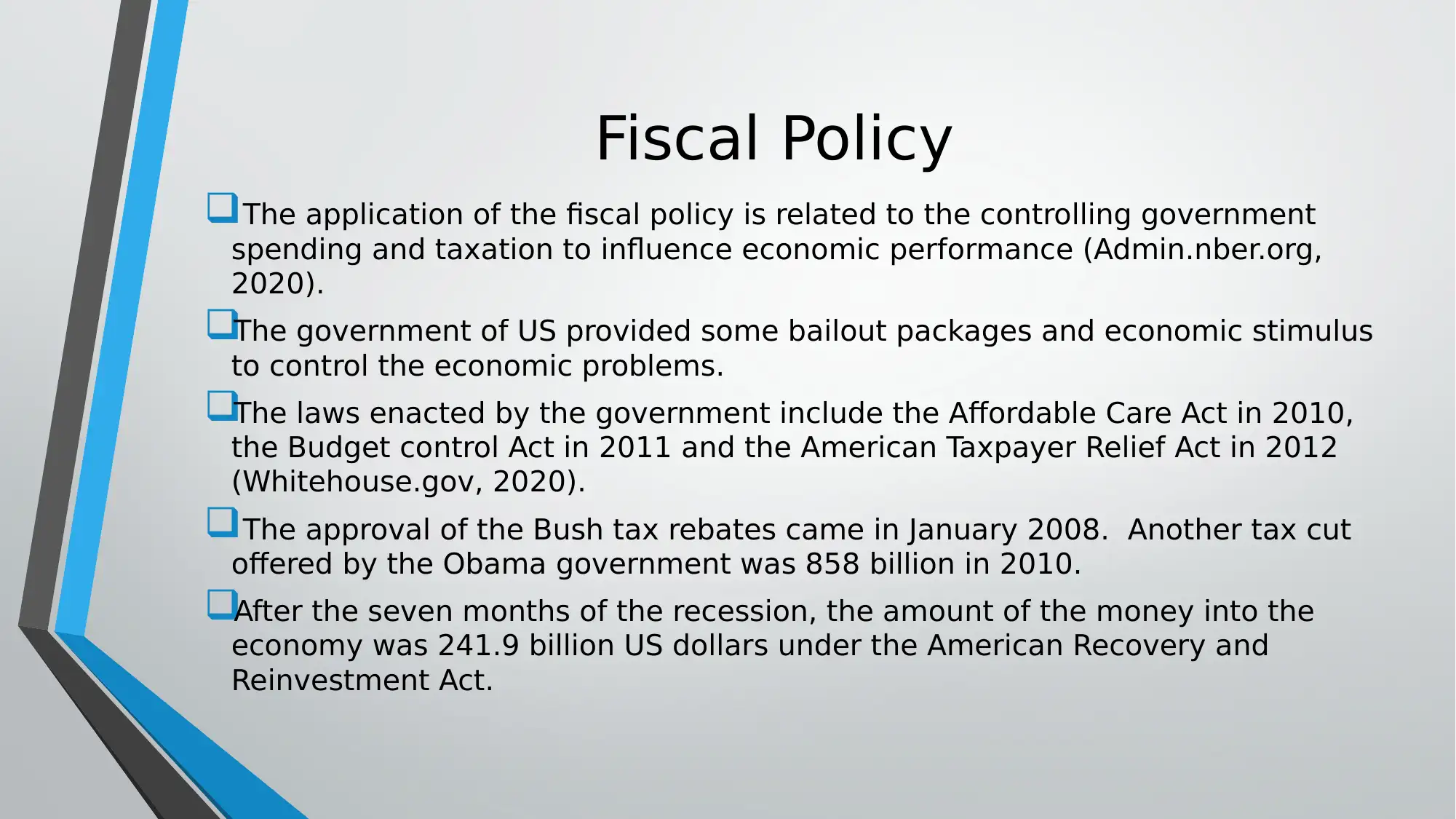
Fiscal Policy
The application of the fiscal policy is related to the controlling government
spending and taxation to influence economic performance (Admin.nber.org,
2020).
The government of US provided some bailout packages and economic stimulus
to control the economic problems.
The laws enacted by the government include the Affordable Care Act in 2010,
the Budget control Act in 2011 and the American Taxpayer Relief Act in 2012
(Whitehouse.gov, 2020).
The approval of the Bush tax rebates came in January 2008. Another tax cut
offered by the Obama government was 858 billion in 2010.
After the seven months of the recession, the amount of the money into the
economy was 241.9 billion US dollars under the American Recovery and
Reinvestment Act.
The application of the fiscal policy is related to the controlling government
spending and taxation to influence economic performance (Admin.nber.org,
2020).
The government of US provided some bailout packages and economic stimulus
to control the economic problems.
The laws enacted by the government include the Affordable Care Act in 2010,
the Budget control Act in 2011 and the American Taxpayer Relief Act in 2012
(Whitehouse.gov, 2020).
The approval of the Bush tax rebates came in January 2008. Another tax cut
offered by the Obama government was 858 billion in 2010.
After the seven months of the recession, the amount of the money into the
economy was 241.9 billion US dollars under the American Recovery and
Reinvestment Act.
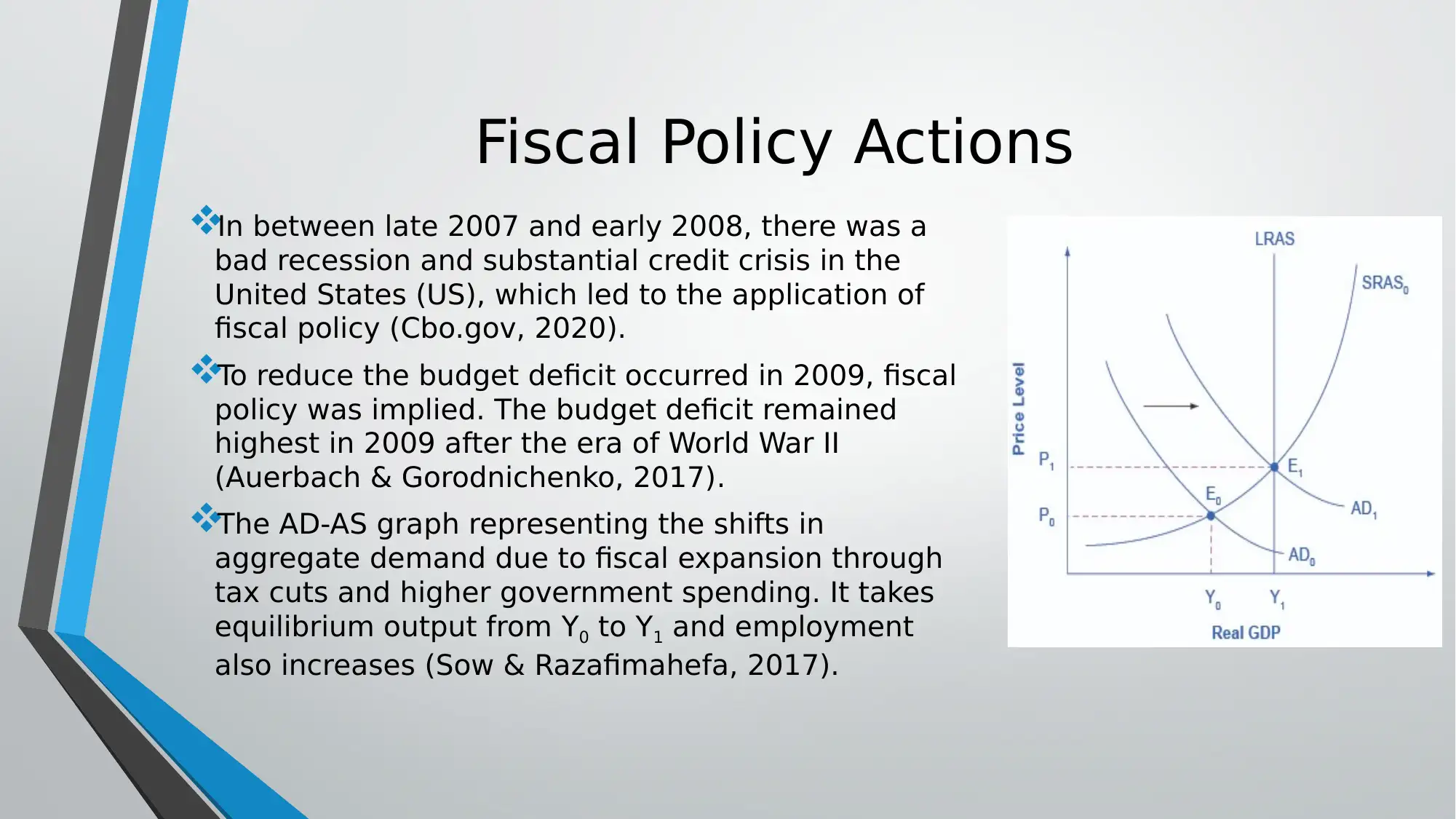
Fiscal Policy Actions
In between late 2007 and early 2008, there was a
bad recession and substantial credit crisis in the
United States (US), which led to the application of
fiscal policy (Cbo.gov, 2020).
To reduce the budget deficit occurred in 2009, fiscal
policy was implied. The budget deficit remained
highest in 2009 after the era of World War II
(Auerbach & Gorodnichenko, 2017).
The AD-AS graph representing the shifts in
aggregate demand due to fiscal expansion through
tax cuts and higher government spending. It takes
equilibrium output from Y0 to Y1 and employment
also increases (Sow & Razafimahefa, 2017).
In between late 2007 and early 2008, there was a
bad recession and substantial credit crisis in the
United States (US), which led to the application of
fiscal policy (Cbo.gov, 2020).
To reduce the budget deficit occurred in 2009, fiscal
policy was implied. The budget deficit remained
highest in 2009 after the era of World War II
(Auerbach & Gorodnichenko, 2017).
The AD-AS graph representing the shifts in
aggregate demand due to fiscal expansion through
tax cuts and higher government spending. It takes
equilibrium output from Y0 to Y1 and employment
also increases (Sow & Razafimahefa, 2017).
⊘ This is a preview!⊘
Do you want full access?
Subscribe today to unlock all pages.

Trusted by 1+ million students worldwide
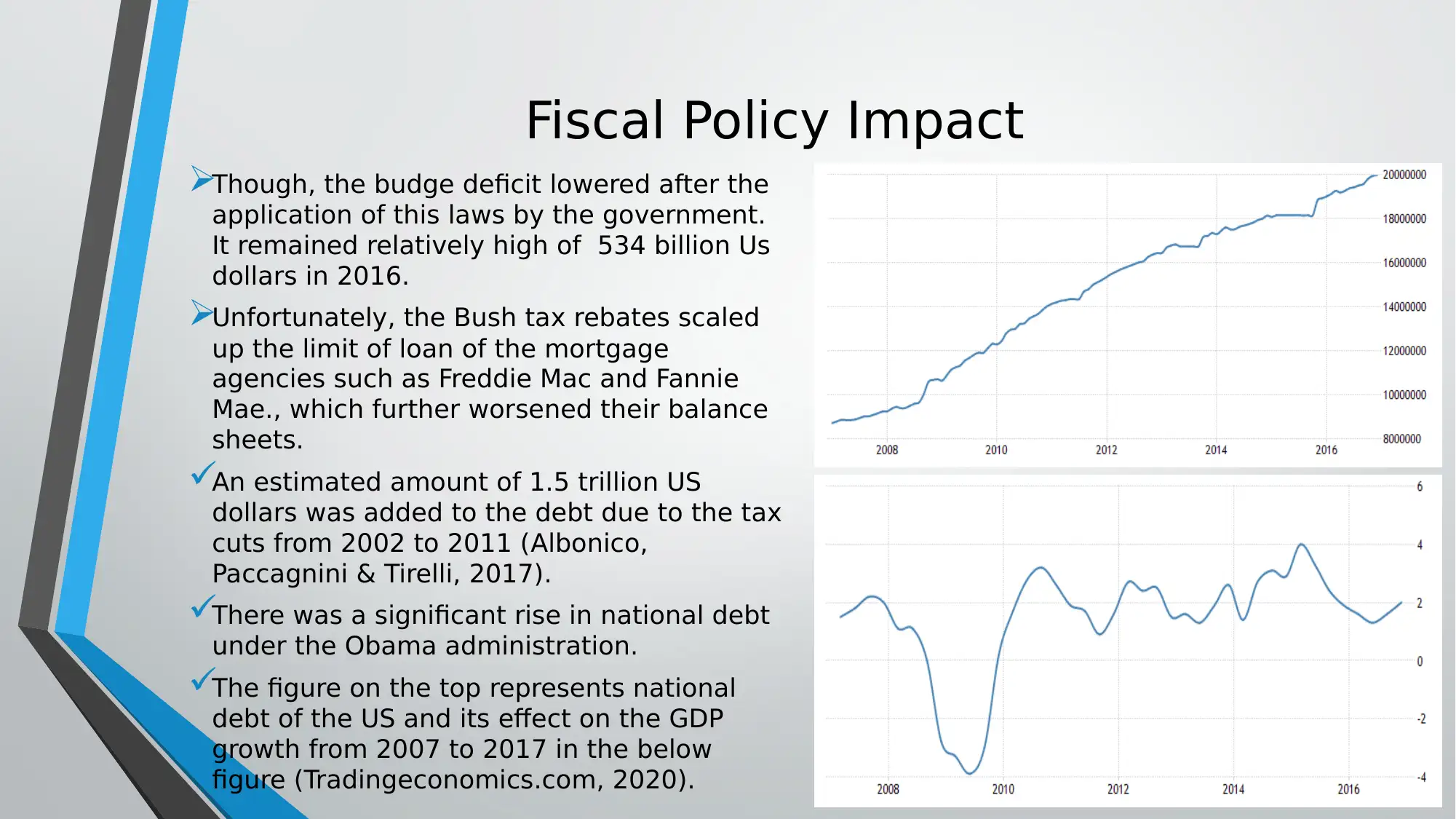
Fiscal Policy Impact
Though, the budge deficit lowered after the
application of this laws by the government.
It remained relatively high of 534 billion Us
dollars in 2016.
Unfortunately, the Bush tax rebates scaled
up the limit of loan of the mortgage
agencies such as Freddie Mac and Fannie
Mae., which further worsened their balance
sheets.
An estimated amount of 1.5 trillion US
dollars was added to the debt due to the tax
cuts from 2002 to 2011 (Albonico,
Paccagnini & Tirelli, 2017).
There was a significant rise in national debt
under the Obama administration.
The figure on the top represents national
debt of the US and its effect on the GDP
growth from 2007 to 2017 in the below
figure (Tradingeconomics.com, 2020).
Though, the budge deficit lowered after the
application of this laws by the government.
It remained relatively high of 534 billion Us
dollars in 2016.
Unfortunately, the Bush tax rebates scaled
up the limit of loan of the mortgage
agencies such as Freddie Mac and Fannie
Mae., which further worsened their balance
sheets.
An estimated amount of 1.5 trillion US
dollars was added to the debt due to the tax
cuts from 2002 to 2011 (Albonico,
Paccagnini & Tirelli, 2017).
There was a significant rise in national debt
under the Obama administration.
The figure on the top represents national
debt of the US and its effect on the GDP
growth from 2007 to 2017 in the below
figure (Tradingeconomics.com, 2020).
Paraphrase This Document
Need a fresh take? Get an instant paraphrase of this document with our AI Paraphraser
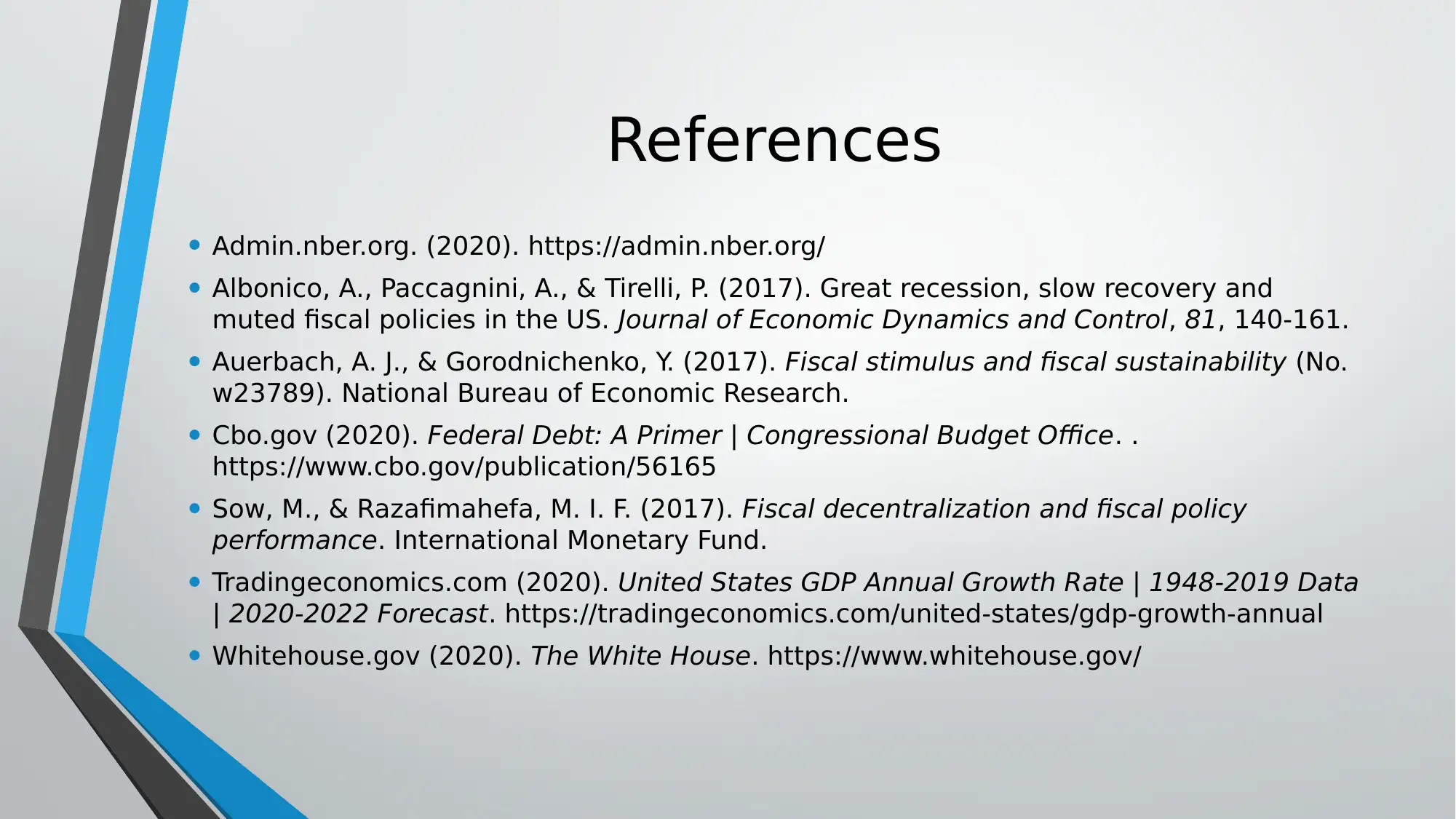
References
• Admin.nber.org. (2020). https://admin.nber.org/
• Albonico, A., Paccagnini, A., & Tirelli, P. (2017). Great recession, slow recovery and
muted fiscal policies in the US. Journal of Economic Dynamics and Control, 81, 140-161.
• Auerbach, A. J., & Gorodnichenko, Y. (2017). Fiscal stimulus and fiscal sustainability (No.
w23789). National Bureau of Economic Research.
• Cbo.gov (2020). Federal Debt: A Primer | Congressional Budget Office. .
https://www.cbo.gov/publication/56165
• Sow, M., & Razafimahefa, M. I. F. (2017). Fiscal decentralization and fiscal policy
performance. International Monetary Fund.
• Tradingeconomics.com (2020). United States GDP Annual Growth Rate | 1948-2019 Data
| 2020-2022 Forecast. https://tradingeconomics.com/united-states/gdp-growth-annual
• Whitehouse.gov (2020). The White House. https://www.whitehouse.gov/
• Admin.nber.org. (2020). https://admin.nber.org/
• Albonico, A., Paccagnini, A., & Tirelli, P. (2017). Great recession, slow recovery and
muted fiscal policies in the US. Journal of Economic Dynamics and Control, 81, 140-161.
• Auerbach, A. J., & Gorodnichenko, Y. (2017). Fiscal stimulus and fiscal sustainability (No.
w23789). National Bureau of Economic Research.
• Cbo.gov (2020). Federal Debt: A Primer | Congressional Budget Office. .
https://www.cbo.gov/publication/56165
• Sow, M., & Razafimahefa, M. I. F. (2017). Fiscal decentralization and fiscal policy
performance. International Monetary Fund.
• Tradingeconomics.com (2020). United States GDP Annual Growth Rate | 1948-2019 Data
| 2020-2022 Forecast. https://tradingeconomics.com/united-states/gdp-growth-annual
• Whitehouse.gov (2020). The White House. https://www.whitehouse.gov/
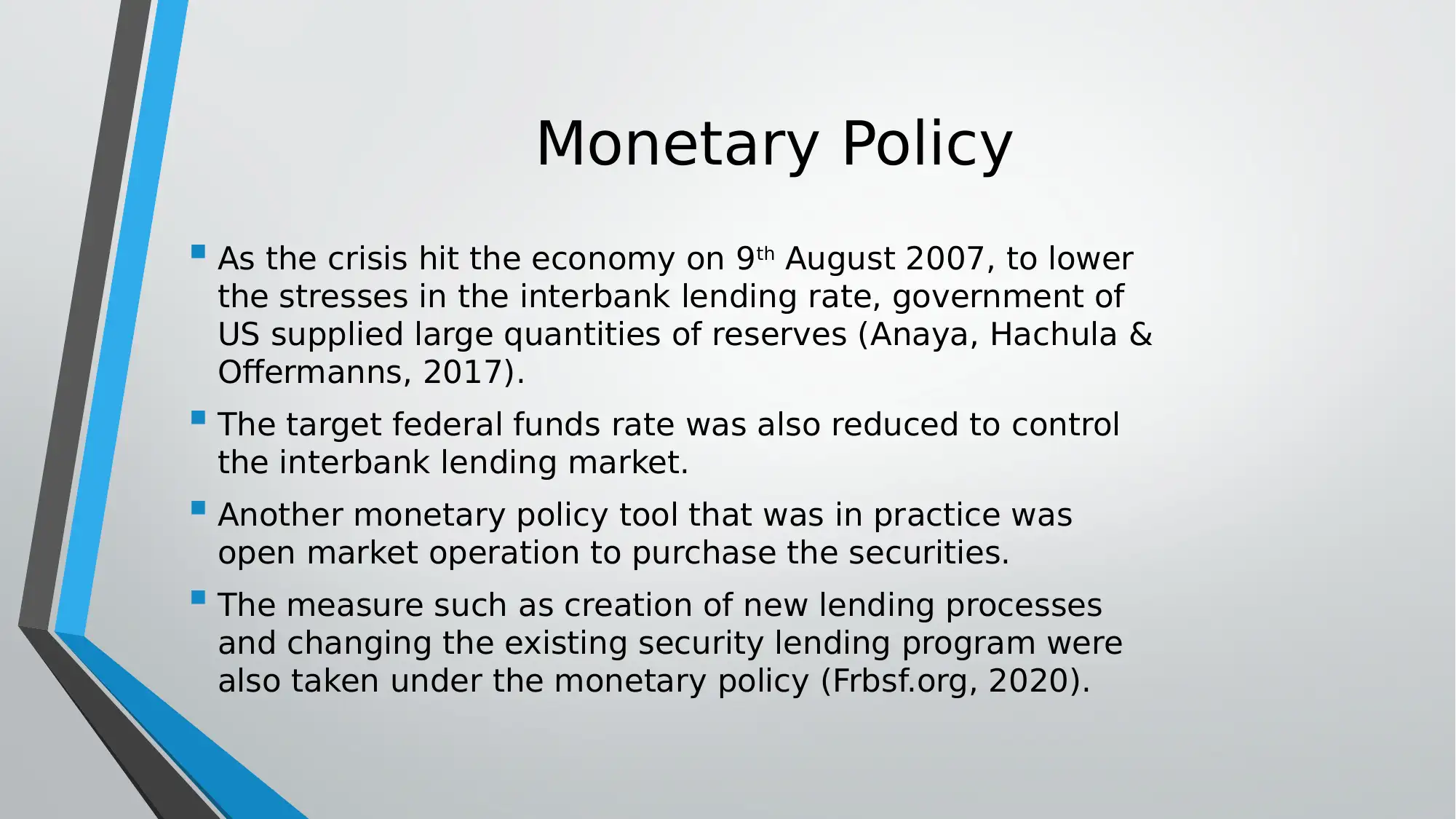
Monetary Policy
As the crisis hit the economy on 9th August 2007, to lower
the stresses in the interbank lending rate, government of
US supplied large quantities of reserves (Anaya, Hachula &
Offermanns, 2017).
The target federal funds rate was also reduced to control
the interbank lending market.
Another monetary policy tool that was in practice was
open market operation to purchase the securities.
The measure such as creation of new lending processes
and changing the existing security lending program were
also taken under the monetary policy (Frbsf.org, 2020).
As the crisis hit the economy on 9th August 2007, to lower
the stresses in the interbank lending rate, government of
US supplied large quantities of reserves (Anaya, Hachula &
Offermanns, 2017).
The target federal funds rate was also reduced to control
the interbank lending market.
Another monetary policy tool that was in practice was
open market operation to purchase the securities.
The measure such as creation of new lending processes
and changing the existing security lending program were
also taken under the monetary policy (Frbsf.org, 2020).
⊘ This is a preview!⊘
Do you want full access?
Subscribe today to unlock all pages.

Trusted by 1+ million students worldwide
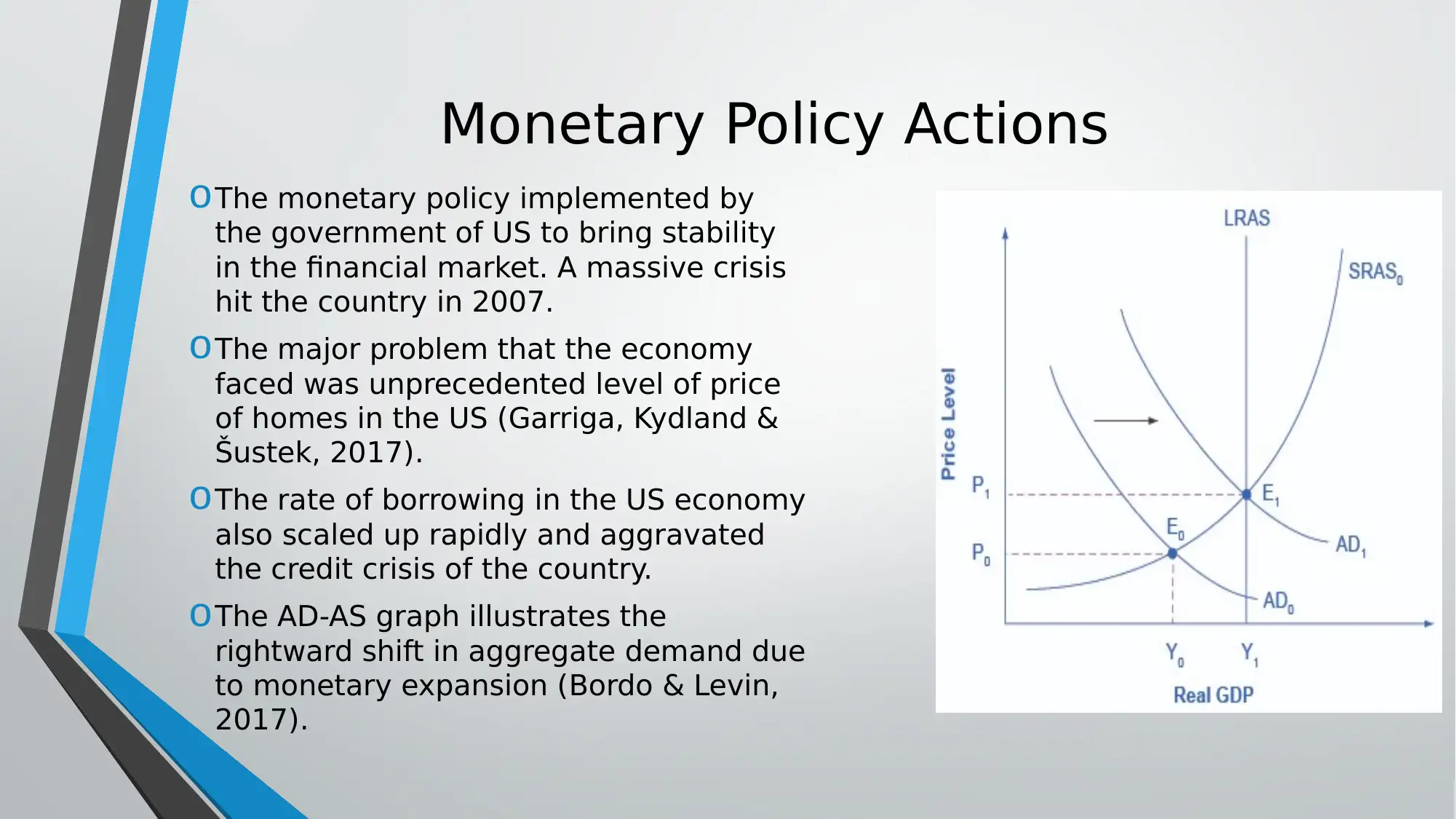
Monetary Policy Actions
oThe monetary policy implemented by
the government of US to bring stability
in the financial market. A massive crisis
hit the country in 2007.
oThe major problem that the economy
faced was unprecedented level of price
of homes in the US (Garriga, Kydland &
Šustek, 2017).
oThe rate of borrowing in the US economy
also scaled up rapidly and aggravated
the credit crisis of the country.
oThe AD-AS graph illustrates the
rightward shift in aggregate demand due
to monetary expansion (Bordo & Levin,
2017).
oThe monetary policy implemented by
the government of US to bring stability
in the financial market. A massive crisis
hit the country in 2007.
oThe major problem that the economy
faced was unprecedented level of price
of homes in the US (Garriga, Kydland &
Šustek, 2017).
oThe rate of borrowing in the US economy
also scaled up rapidly and aggravated
the credit crisis of the country.
oThe AD-AS graph illustrates the
rightward shift in aggregate demand due
to monetary expansion (Bordo & Levin,
2017).
Paraphrase This Document
Need a fresh take? Get an instant paraphrase of this document with our AI Paraphraser
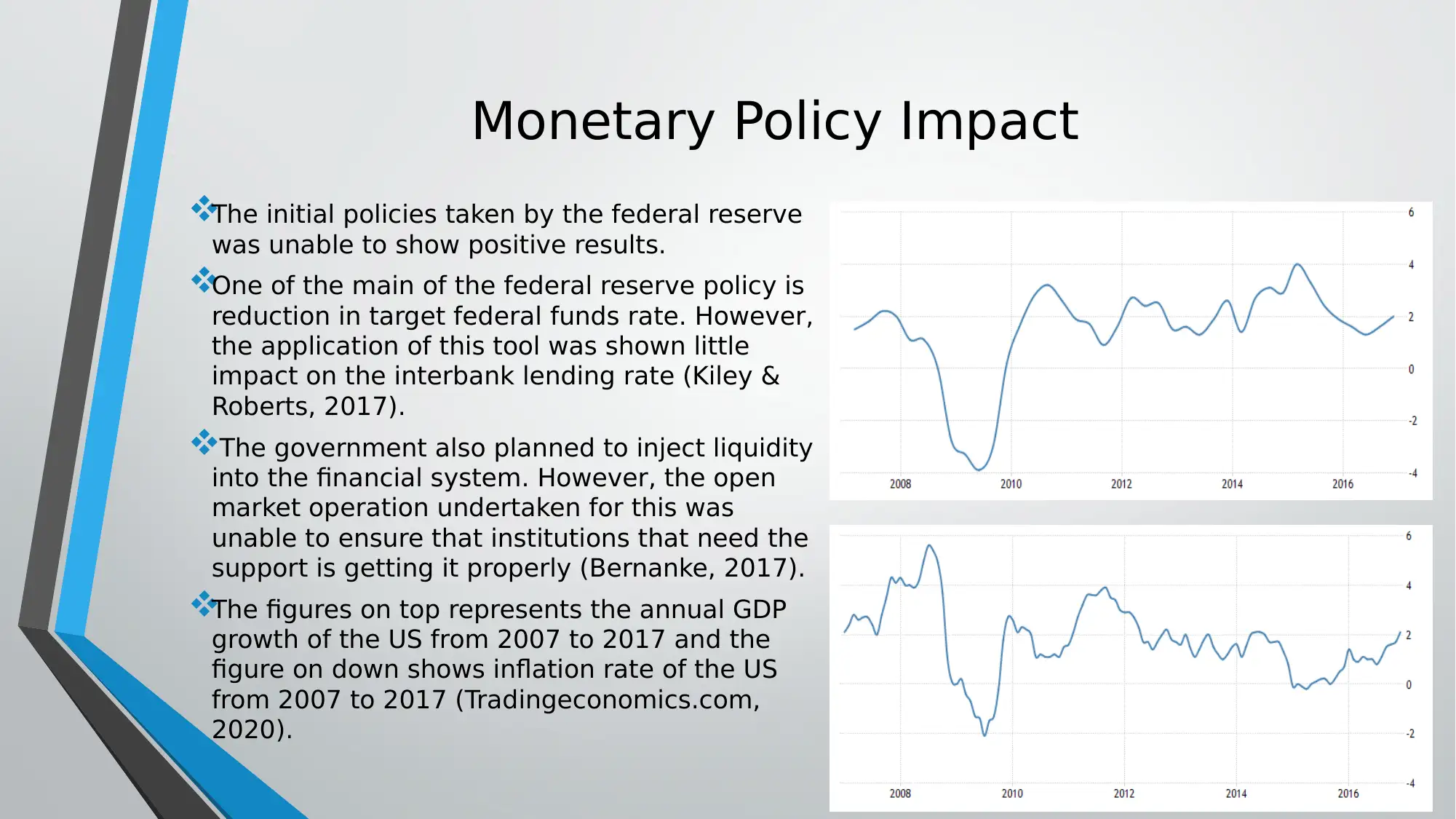
Monetary Policy Impact
The initial policies taken by the federal reserve
was unable to show positive results.
One of the main of the federal reserve policy is
reduction in target federal funds rate. However,
the application of this tool was shown little
impact on the interbank lending rate (Kiley &
Roberts, 2017).
The government also planned to inject liquidity
into the financial system. However, the open
market operation undertaken for this was
unable to ensure that institutions that need the
support is getting it properly (Bernanke, 2017).
The figures on top represents the annual GDP
growth of the US from 2007 to 2017 and the
figure on down shows inflation rate of the US
from 2007 to 2017 (Tradingeconomics.com,
2020).
The initial policies taken by the federal reserve
was unable to show positive results.
One of the main of the federal reserve policy is
reduction in target federal funds rate. However,
the application of this tool was shown little
impact on the interbank lending rate (Kiley &
Roberts, 2017).
The government also planned to inject liquidity
into the financial system. However, the open
market operation undertaken for this was
unable to ensure that institutions that need the
support is getting it properly (Bernanke, 2017).
The figures on top represents the annual GDP
growth of the US from 2007 to 2017 and the
figure on down shows inflation rate of the US
from 2007 to 2017 (Tradingeconomics.com,
2020).
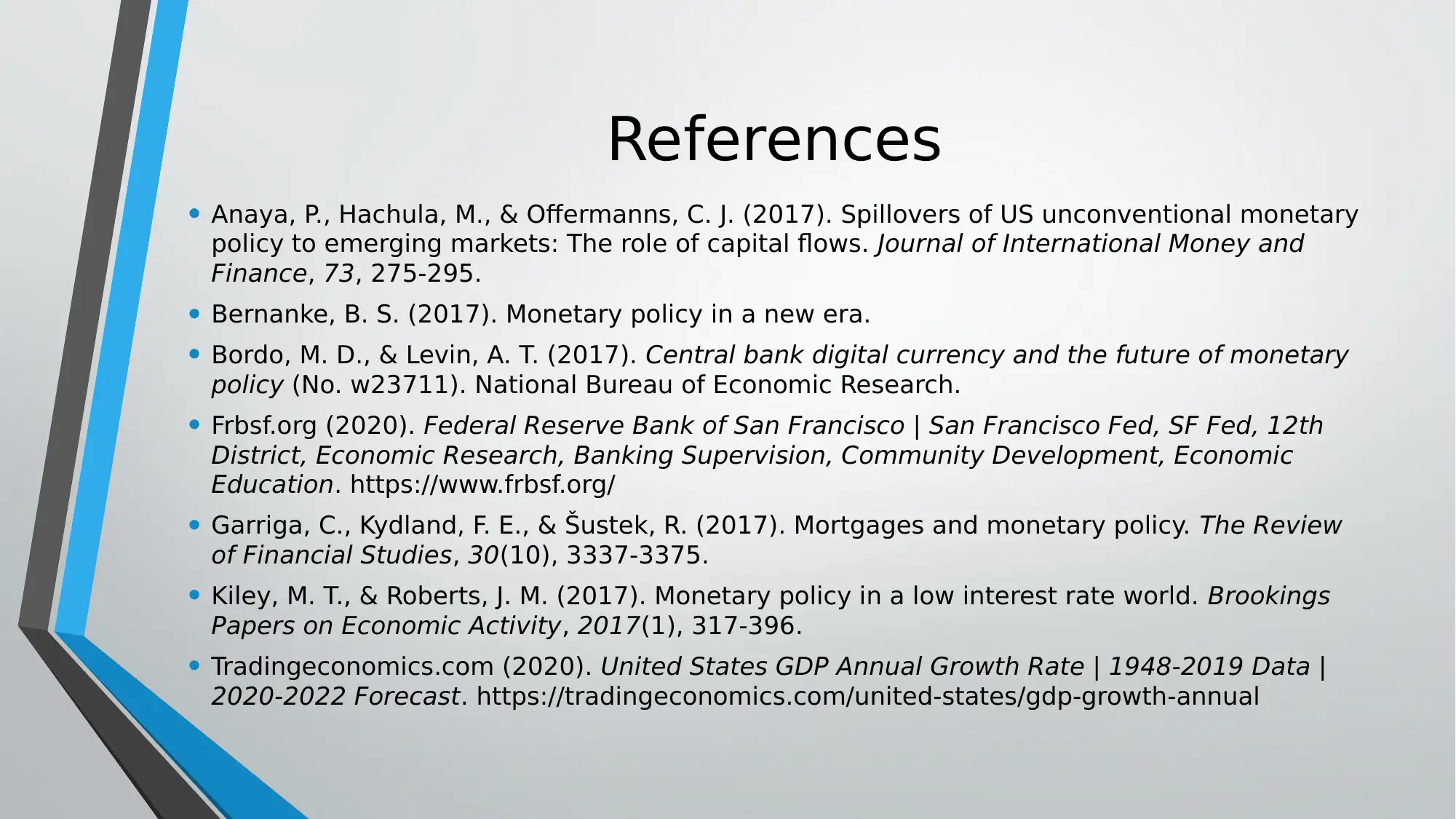
References
• Anaya, P., Hachula, M., & Offermanns, C. J. (2017). Spillovers of US unconventional monetary
policy to emerging markets: The role of capital flows. Journal of International Money and
Finance, 73, 275-295.
• Bernanke, B. S. (2017). Monetary policy in a new era.
• Bordo, M. D., & Levin, A. T. (2017). Central bank digital currency and the future of monetary
policy (No. w23711). National Bureau of Economic Research.
• Frbsf.org (2020). Federal Reserve Bank of San Francisco | San Francisco Fed, SF Fed, 12th
District, Economic Research, Banking Supervision, Community Development, Economic
Education. https://www.frbsf.org/
• Garriga, C., Kydland, F. E., & Šustek, R. (2017). Mortgages and monetary policy. The Review
of Financial Studies, 30(10), 3337-3375.
• Kiley, M. T., & Roberts, J. M. (2017). Monetary policy in a low interest rate world. Brookings
Papers on Economic Activity, 2017(1), 317-396.
• Tradingeconomics.com (2020). United States GDP Annual Growth Rate | 1948-2019 Data |
2020-2022 Forecast. https://tradingeconomics.com/united-states/gdp-growth-annual
• Anaya, P., Hachula, M., & Offermanns, C. J. (2017). Spillovers of US unconventional monetary
policy to emerging markets: The role of capital flows. Journal of International Money and
Finance, 73, 275-295.
• Bernanke, B. S. (2017). Monetary policy in a new era.
• Bordo, M. D., & Levin, A. T. (2017). Central bank digital currency and the future of monetary
policy (No. w23711). National Bureau of Economic Research.
• Frbsf.org (2020). Federal Reserve Bank of San Francisco | San Francisco Fed, SF Fed, 12th
District, Economic Research, Banking Supervision, Community Development, Economic
Education. https://www.frbsf.org/
• Garriga, C., Kydland, F. E., & Šustek, R. (2017). Mortgages and monetary policy. The Review
of Financial Studies, 30(10), 3337-3375.
• Kiley, M. T., & Roberts, J. M. (2017). Monetary policy in a low interest rate world. Brookings
Papers on Economic Activity, 2017(1), 317-396.
• Tradingeconomics.com (2020). United States GDP Annual Growth Rate | 1948-2019 Data |
2020-2022 Forecast. https://tradingeconomics.com/united-states/gdp-growth-annual
⊘ This is a preview!⊘
Do you want full access?
Subscribe today to unlock all pages.

Trusted by 1+ million students worldwide
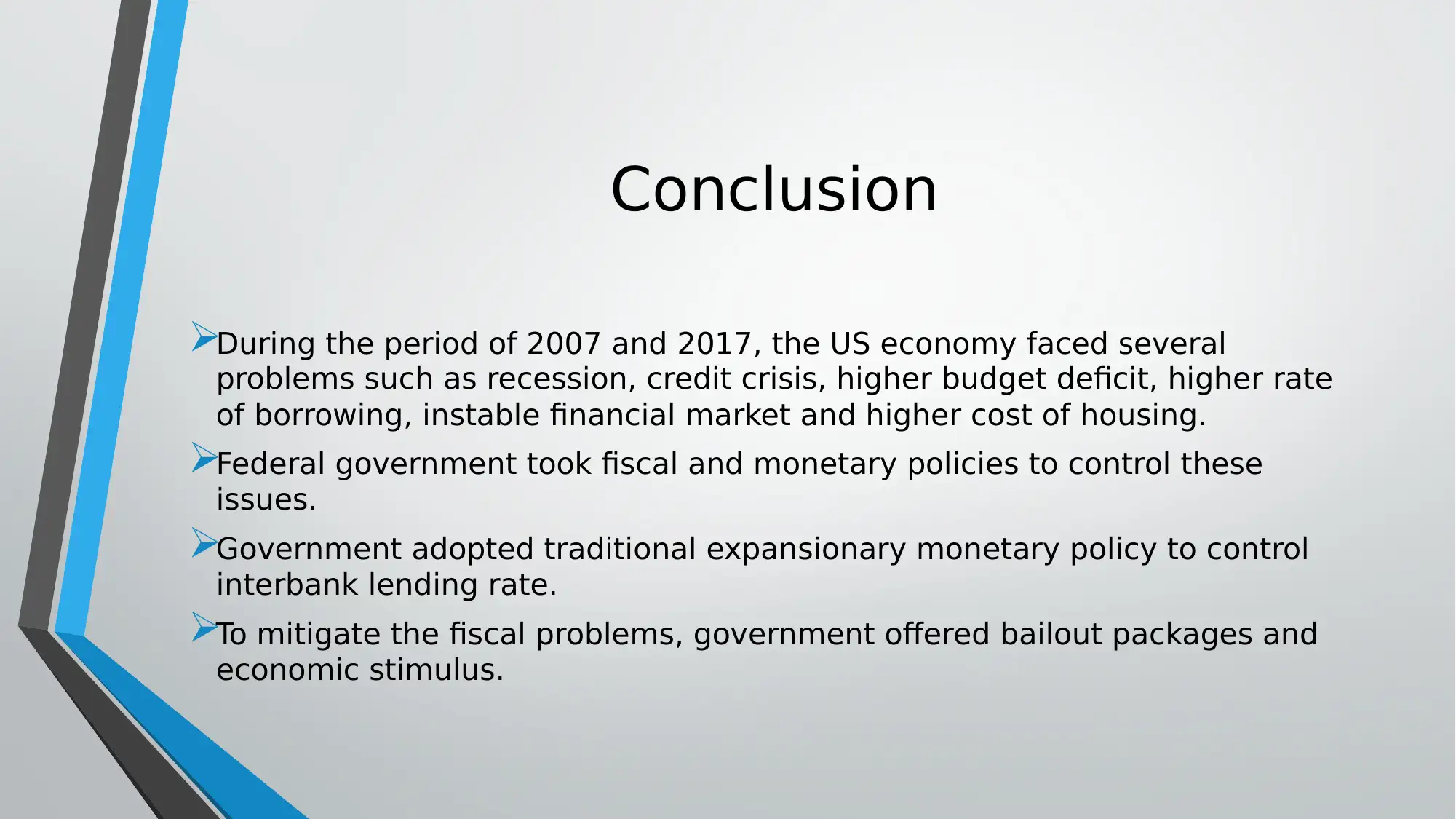
Conclusion
During the period of 2007 and 2017, the US economy faced several
problems such as recession, credit crisis, higher budget deficit, higher rate
of borrowing, instable financial market and higher cost of housing.
Federal government took fiscal and monetary policies to control these
issues.
Government adopted traditional expansionary monetary policy to control
interbank lending rate.
To mitigate the fiscal problems, government offered bailout packages and
economic stimulus.
During the period of 2007 and 2017, the US economy faced several
problems such as recession, credit crisis, higher budget deficit, higher rate
of borrowing, instable financial market and higher cost of housing.
Federal government took fiscal and monetary policies to control these
issues.
Government adopted traditional expansionary monetary policy to control
interbank lending rate.
To mitigate the fiscal problems, government offered bailout packages and
economic stimulus.
Paraphrase This Document
Need a fresh take? Get an instant paraphrase of this document with our AI Paraphraser
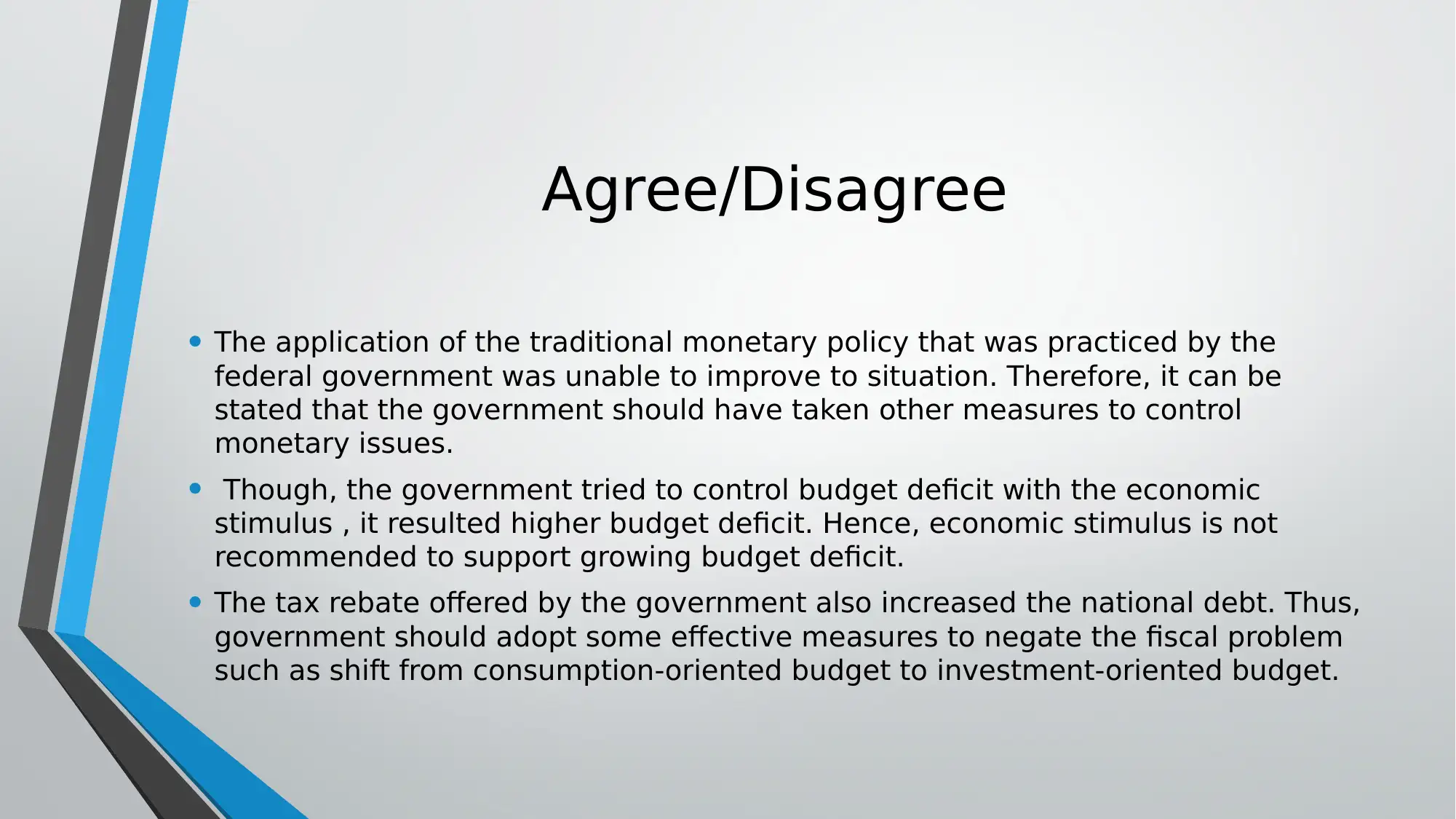
Agree/Disagree
• The application of the traditional monetary policy that was practiced by the
federal government was unable to improve to situation. Therefore, it can be
stated that the government should have taken other measures to control
monetary issues.
• Though, the government tried to control budget deficit with the economic
stimulus , it resulted higher budget deficit. Hence, economic stimulus is not
recommended to support growing budget deficit.
• The tax rebate offered by the government also increased the national debt. Thus,
government should adopt some effective measures to negate the fiscal problem
such as shift from consumption-oriented budget to investment-oriented budget.
• The application of the traditional monetary policy that was practiced by the
federal government was unable to improve to situation. Therefore, it can be
stated that the government should have taken other measures to control
monetary issues.
• Though, the government tried to control budget deficit with the economic
stimulus , it resulted higher budget deficit. Hence, economic stimulus is not
recommended to support growing budget deficit.
• The tax rebate offered by the government also increased the national debt. Thus,
government should adopt some effective measures to negate the fiscal problem
such as shift from consumption-oriented budget to investment-oriented budget.

⊘ This is a preview!⊘
Do you want full access?
Subscribe today to unlock all pages.

Trusted by 1+ million students worldwide
1 out of 12
Related Documents
Your All-in-One AI-Powered Toolkit for Academic Success.
+13062052269
info@desklib.com
Available 24*7 on WhatsApp / Email
![[object Object]](/_next/static/media/star-bottom.7253800d.svg)
Unlock your academic potential
Copyright © 2020–2025 A2Z Services. All Rights Reserved. Developed and managed by ZUCOL.



